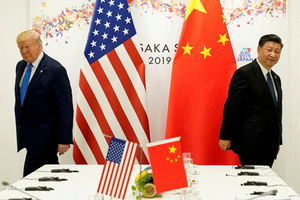Zimbabwe launches gold coins to cushion economy

Zimbabwe Reserve Bank governor John Mangudya displays the country's new "Mosi-oa-Tunya" gold coin in Harare on July 25, 2022. PHOTO | AFP
What you need to know:
- Gold is Zimbabwe’s largest export earner. Last year the country produced 35.2 metric tonnes and this year the government says it is targeting 40 metric tonnes as it tries to push revenues from the mining sector and breathe life into the ailing economy.
Zimbabwe has introduced a new gold-backed digital currency as it battles to stop re-dollarisation, which President Emmerson Mnangagwa’s government fears will spell doom for the country’s fragile economy.
The country’s central bank said the digital tokens, also known as Zimbabwe Gold (ZiG), that are dominated in milligrams, can be used by both individuals and corporates to transact.
They can be bought from banks in local currency and in US dollars while goods and services will also be priced in ZiG.
Bank clients can transact using ZiG accounts through point of sale machines or via online payments.
In May, Zimbabwe unveiled gold coins for peer-to-peer and peer-to-business transactions as well as to act as a store of value as the country’s currency continued to lose ground against major currencies.
Holders of physical gold coins are able to exchange or convert them through the banking system into gold-backed digital tokens.
This latest intervention hit the market to lukewarm reception from economists and ordinary Zimbabweans, who foresee an inevitable return to dollarisation.
Zimbabwe reintroduced its own currency in 2019 after a decade of dollarisation that followed record breaking hyperinflation under Robert Mugabe.
The Zimbabwe dollar has, however, been losing value rapidly against major currencies and this week it was trading at ZWL$5,252 to $1 and on the much-used parallel market $1 could fetch ZWL$10,000.
At the height of the Covid-19 pandemic, the government introduced a multi-currency system to protect the local currency and authorities now estimate that 80 percent of transactions in the economy are occurring in US dollars.
Advisory firm IH Securities said Zimbabwe’s official exchange rate weakened to $1: ZWL$ 5,252,6558 in September from $1: ZWL$4,604,6233 the previous month.
“The parallel market experienced similar movements, with the rate increasing by 12.90 percent within the same period,” IH Securities said in its latest bulletin.
“There was a marked growth in Zimbabwe dollar liquidity in the market and we expect this upward trend to continue into the final quarter of the year, exerting persistent pressure on the exchange rate.”
According to the US’ Famine Early Warning Systems, prices of some basic commodities increased by 20 percent in September compared to August following increases of 15 and 18 percent in the parallel and official market exchanges, respectively.
It is against this background that economists feel the new digital currency will do little to halt the collapse of the Zimbabwe dollar.
Steve Hanke, a professor of economics at Johns Hopkins University, who has been tracking Zimbabwe’s currency troubles, says the country “must dollarise as it did from 2009 to 2019.”
But the Confederation of Zimbabwe Industries (CZI), which represents the majority of the country’s big businesses, are pushing the government to explore measures to stop the full dollarisation of the economy.
“Although the measures managed to enhance stability, the economy has become more dollarised due to the liquidity squeeze on the (Zimbabwe dollar),” CZI said in its policy brief for September.
“Foreign currency denominated-loans constituted 94 percent of the banking sector loan book as at June 30, 2023.
“Thus, it is now imperative for the government to determine the optimal Zimbabwe dollar liquidity that is enough to prevent the economy from full dollarisation by default.”
Robert Mubaiwa, the head of Zimbabwe’s foreign currency dominated Victoria Falls Stock Exchange, said a digital currency will only work if the authorities instill confidence in the market.
“What is critical in terms of whatever is going to be introduced as currency is to have infrastructure that helps people understand what the product is all about and how to use the product in the long run,” Mubaiwa said.
“As long as we do not have sufficient safeguards that inspire confidence it becomes very difficult, but we believe the authorities are making the necessary steps that help in educating the market and ensuring that the product is acceptable.”
Gold is Zimbabwe’s largest export earner. Last year the country produced 35.2 metric tonnes and this year the government says it is targeting 40 metric tonnes as it tries to push revenues from the mining sector and breathe life into the ailing economy.
However, watchdogs say most of the country’s gold is sold through unofficial channels, with a documentary produced by a Qatar-based international news network exposing how individuals linked to the country’s political elite smuggle the mineral to refineries in Dubai.
Some smugglers claimed in a secret recording that they had direct access to President Mnangagwa and his family.
Zimbabwe’s central bank denied any links to the smugglers after they claimed that they used it to launder money through its gold buying schemes.





